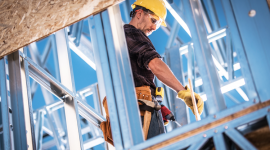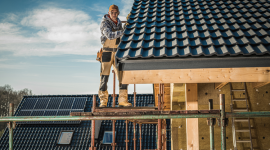Your roof is one of the most important parts of your home, but it’s easy to forget about it until something goes wrong. One serious issue that homeowners should never overlook is the risk of a roof collapse. It’s not something that happens out of nowhere. Most of the time, there are warning signs that give you a chance to step in and address them before the damage becomes too big to fix quickly or affordably.
In Albuquerque, intense sun, sudden monsoons, and windy conditions can wear down roofing materials quicker than in milder climates. Over time, that can lead to the kind of damage that compromises your roof’s strength. That’s why paying attention to changes, big or small, is key. Recognizing early clues can keep your family safe and help you avoid bigger issues down the line.
Common Early Warning Signs Of Roof Collapse
Spotting warning signs early can make all the difference. Most roof problems give some kind of hint before they turn into something serious. If you notice any of the signs below, don’t brush them off. They could point to much larger issues.
Here are a few red flags to look out for:
– Sagging or dipping parts of the roof. This could be an indicator that part of the roof structure is weakening or bowing under weight. In homes with older roofing, this can happen when materials start to break down.
– New or spreading cracks in the ceiling. If lines appear where there were none before, or existing cracks start widening, that can be a sign your ceiling is under stress from above.
– Leaks that keep coming back. Spotting water drops, brown stains, or moisture patches might seem minor at first, but if they reappear even after repair, it may point to something more serious behind the scenes.
– Creaking, groaning, or popping noises from overhead. These noises often happen when materials shift under strain. If your home starts sounding different, trust your ears. It could be your roof struggling to handle pressure.
In Albuquerque, late summer storms can unload a lot of water onto light roofing in just minutes. Monsoon moisture can pool in areas with poor drainage or weakened support. Where water sits, weight builds. That weight may cause small parts to bend or break and soon enough, a larger section can give way.
One homeowner near Northeast Heights reported hearing strange popping sounds just before a heavy rain rolled in. Sure enough, one corner of the roof began to sink later that week. Turns out, a weak spot had been slowly letting in moisture, and the plywood underneath couldn’t hold anymore. They caught it in time, but only because they paid attention to the signs.
A small issue today could turn into a major repair next month. If you notice anything mentioned above, it’s time to stop and reassess. Damage won’t fix itself. If it reaches the point of collapse, the repairs won’t be simple or easy.
Structural Damage And Deformation
Not all warning signs happen inside the house. Some of the most important clues show up right on the roof itself. Looking at your roof from the ground, or during a professional inspection, can help catch problems you’d never see otherwise.
Buildings naturally settle over time, but when parts of your roof shift, it’s not something to ignore. A roof that looks uneven or warped might be showing signs of structural stress. If your roofline was once flat but now has small dips or bulges, start asking questions. Those changes could mean the frame underneath is starting to bend or break.
Keep an eye out for:
– Warped or sagging rooflines that don’t match the rest of the house
– Bulges under the roofing material that look like bubbles or domes
– Shingles or tiles that appear to lift or shift on their own
– Flashing pulling away from chimneys or roof edges
– Areas where roofing seams look split or uneven
These issues often show up after storms, after snowfall that doesn’t fully melt, or after long stretches of extreme heat. Albuquerque’s sun can dry out older roofing materials fast. After years of baking in the heat, nails loosen, wood dries and separates, and seams give way. Once that happens, even a small shift in the structure can cause pieces to sag or swell out of place.
That’s why it’s smart to get a roof inspection before and after stormy parts of the year. A trained eye can pinpoint odd angles or separations that the average homeowner might miss. Regular inspections don’t just help you catch problems. They make it easier to track how your roof changes over time. When things start going the wrong way, you’re in a better spot to fix them early.
Interior Indicators To Watch For
Some of the clearest warnings of roof damage actually show up inside your home. Water has a way of revealing issues you can’t always see from the outside. Whether it slips through cracked shingles or works its way past worn-out flashing, moisture inside the house often means something up top isn’t doing its job.
Look for the following signs inside your home:
– Water stains on the ceiling or upper walls that grow or change color over time
– Mold or mildew odors, especially in rooms where they weren’t present before
– Paint that bubbles, peels, or flakes on the ceiling or near the top corners of walls
– Soft or sagging drywall in the ceiling
– Increased humidity or dampness in attic spaces
These signals usually start small but tend to get worse as time goes on. If your ceiling begins to stain after a summer rain, it might be tempting to just repaint it and move on. But the source of that moisture, whether it’s a broken shingle, a loose nail hole, or worn waterproofing, won’t go away without attention.
In Albuquerque homes, the transition from hot, dry summer days to a sudden burst of monsoon rain can shock aging roofing materials. Water can find any tiny weak point and enter where it’s least expected. Once inside, that moisture gets trapped in insulation or seeps into ceiling panels. Over time, it softens materials that should stay dry and contributes to bigger structural problems.
Ignoring these signs puts both your roof and your indoor spaces at risk. The earlier you recognize indoor symptoms, the easier it is to stop the damage from spreading. Even if something looks minor, having a professional assess the situation can prevent ceiling collapse, wood rot, electrical issues, or worse. Inside indicators deserve your attention just as much as outdoor ones.
Regular Maintenance Keeps Your Roof Safe
Spotting signs of damage is one part of the job. The other part is keeping the roof in good shape so those issues don’t start in the first place. Preventative roof care may sound like a chore, but it pays off every time a storm rolls through Albuquerque.
Monsoon season calls for different attention. Flash flooding and desert winds bring tree branches, dust, and rooftop debris. After a storm, take a walk around your home and check for materials knocked loose or branches sitting on your roof. If you can’t see clearly from the ground, bring in a pro. Slipping on wet roofing after a heavy rain is way more dangerous than most people think.
Here’s a simple maintenance routine to follow throughout the year:
1. Clean out gutters and downspouts after every major storm to avoid water pooling at the roof’s edge.
2. Check attic spaces for signs of light coming through the roof boards. That could mean holes or gaps.
3. Have missing, broken, or curled-up shingles replaced before the next rain hits.
4. Remove tree limbs that touch or hang closely over your roof to prevent branches from scraping or puncturing.
5. Schedule a full roof inspection at least once a year or after major weather events.
These steps help you catch minor wear before it becomes major damage. Roofing materials expand and contract in heat, and with Albuquerque’s temperature shifts, that kind of movement happens a lot. Over time, sealants break down, fasteners loosen, and roofing layers shift.
Investing time in your roof’s care can mean fewer emergency repairs, lower long-term costs, and better home safety overall. The more consistent the maintenance, the stronger your roof will be when storm season returns.
Keeping Your Home Safe and Secure
Understanding what to watch for can help protect your home from major roof problems. Spotting signs like dips in the roofline, bubbling under shingles, or stains on the ceiling isn’t about being overly cautious. It’s about being smart. Repairs tend to be easier and quicker when problems are caught early, long before they can spread or become a hazard.
Staying ahead of roof issues can feel more doable when you know what signs matter. Albuquerque’s unique climate adds stress to roofing materials throughout the year, especially during monsoon months and dry spells. That’s why paying attention and staying proactive can make a real difference.
Keeping your roof safe is really about watching, maintaining, and acting before small things become big problems. You don’t have to know it all, but recognizing even one early clue can make the difference between a basic repair and a full rebuild. It’s your home. Keep it safe from the top down.
Ensure your home’s protection and your peace of mind with expert attention to residential roofing. Sol System Builders understands the challenges Albuquerque’s climate presents and offers tailored solutions to keep your roof strong year-round. Trust us to maintain the integrity of your roof with reliable maintenance and effective preventive measures. Explore our comprehensive services for residential roofing and feel confident in your home’s safety from the top down.





